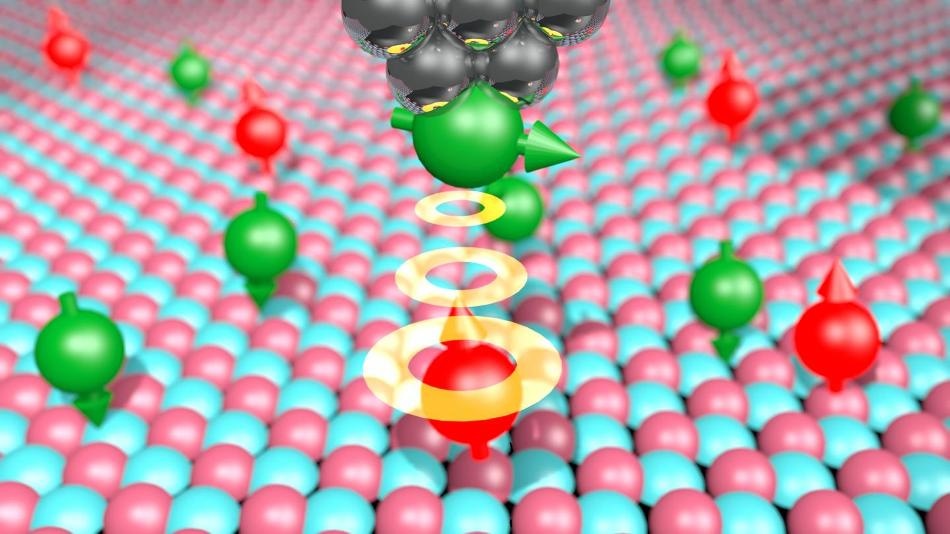Jul 2 2019
A research team at the Center for Quantum Nanoscience (QNS) within the Institute for Basic Science (IBS) at Ewha Womans University has achieved a significant scientific breakthrough by carrying out the smallest magnetic resonance imaging (MRI) in the world.
 Single magnetic atoms are deposited on a surface of magnesium oxide. They are imaged by the magnetic tip of a scanning tunneling microscope which also allows researchers to perform an MRI scan of the atom's magnetic field. (Image credit: Philip Willke et al.)
Single magnetic atoms are deposited on a surface of magnesium oxide. They are imaged by the magnetic tip of a scanning tunneling microscope which also allows researchers to perform an MRI scan of the atom's magnetic field. (Image credit: Philip Willke et al.)
QNS scientists, in global collaboration with coworkers from the United States, used their latest method to view the magnetic field of individual atoms.
Currently, an MRI is regularly done in hospitals as a part of imaging for diagnostics. MRIs find the density of spins—the basic magnets in protons and electrons—in the human body. Usually, an MRI scan requires billions and billions of spins. The latest discoveries, reported on July 1st, 2019, in Nature Physics, reveal that at present, this process is also feasible for a single atom on a surface. The team performed this process using a scanning tunneling microscope, which comprises an atomically sharp metal tip that can allow scientists to image and probe individual atoms by scanning the tip across the surface.
Both iron and titanium, which were investigated in this work, were found to be magnetic. By careful sample preparation, the atoms were readily visible through the scanning tunneling microscope. Later, the scientists used the tip of the microscope similar to an MRI machine to map the 3D magnetic field produced by the atoms with unparalleled resolution. They achieved this by attaching another spin cluster to their microscope’s sharp metal tip. Similar to ordinary magnets, the two spins could repel or attract each other based on their relative position. The scientists, by sweeping the tip spin cluster over the atom on the surface, traced the magnetic interaction.
It turns out that the magnetic interaction we measured depends on the properties of both spins, the one on the tip and the one on the sample. For example, the signal that we see for iron atoms is vastly different from that for titanium atoms. This allows us to distinguish different kinds of atoms by their magnetic field signature and makes our technique very powerful.
Dr Philip Willke, Study Lead Author, QNS
The scientists have decided to use their single-atom MRI to map the distribution of the spin in more complicated structures like magnetic materials and molecules.
“Many magnetic phenomena take place on the nanoscale, including the recent generation of magnetic storage devices,” stated Dr Yujeong Bae also from QNS and Study co-author. “We now plan to study a variety of systems using our microscopic MRI.”
The potential to examine the magnetic structure on the nanoscale can help to create new materials and drugs. In addition, the researchers desired to use this type of MRI to characterize and control quantum systems. These have gained considerable attention for future computation schemes (also called quantum computing).
I am very excited about these results. It is certainly a milestone in our field and has very promising implications for future research. The ability to map spins and their magnetic field with previously unimaginable precision, allows us to gain deeper knowledge about the structure of matter and opens new fields of basic research.
Professor Andreas Heinrich, Director, QNS
The Center for Quantum Nanoscience, on the campus of Ewha Womans University in Seoul, South Korea, is a world-leading research center that fuses nanoscience and quantum to manage the quantum future through fundamental research. With the support of Korea’s Institute for Basic Science, which was founded in 2011, the Center for Quantum Nanoscience used decades of QNS Director Andreas J. Heinrich’s (A Boy and His Atom, IBM, 2013) scientific leadership to lay the groundwork for future technology by exploring the use of quantum behavior atom-by-atom on the surfaces with highest precision.